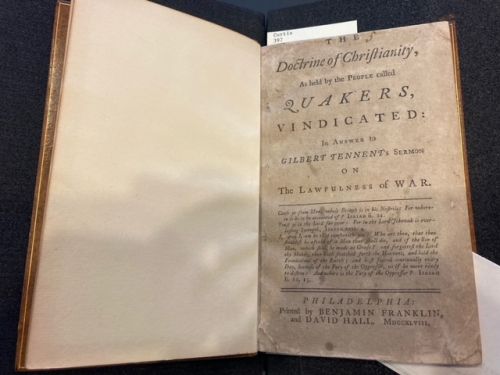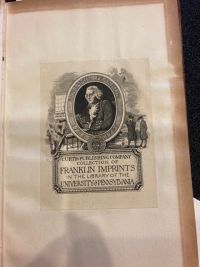A Response to Gilbert Tennent on The Doctrine of Christianity: Difference between revisions
No edit summary |
|||
| Line 1: | Line 1: | ||
[[File:Titlepagefranklin.jpeg|500px|thumb|]]Printed in Philadelphia in 1748 by Benjamin Franklin and David Hall, this book is a storied piece of Americana with two distinct purposes. The codex is only 52 pages long and was initially only intended for local circulation. It was written by a man named John Smith in response to a sermon given locally by Gilbert Tennent. Sometime after the initial circulation, this particular copy came into the possession of the Curtis Publishing Company. The original codex was rebound and preserved as a piece of ephemera for historical significance. In the early 20th century | [[File:Titlepagefranklin.jpeg|500px|thumb|]]Printed in Philadelphia in 1748 by Benjamin Franklin and David Hall, this book is a storied piece of Americana with two distinct purposes. The codex is only 52 pages long and was initially only intended for local circulation. It was written by a man named John Smith in response to a sermon given locally by Gilbert Tennent. Sometime after the initial circulation, this particular copy came into the possession of the Curtis Publishing Company. The original codex was rebound and preserved as a piece of ephemera for historical significance. In the early 20th century the Curtis Publishing Company donated a large collection of Ben Franklin’s prints to the University of Pennsylvania’s Kislak center for Special Collections, Rare Books and Manuscripts, where it is still housed today. This book showcases the physical transformations that a piece of ephemera undergoes as it moves past the purpose of its initial inception. | ||
==Historical Significance - Colonial Beginnings == | ==Historical Significance - Colonial Beginnings == | ||
Revision as of 03:42, 6 May 2024

Printed in Philadelphia in 1748 by Benjamin Franklin and David Hall, this book is a storied piece of Americana with two distinct purposes. The codex is only 52 pages long and was initially only intended for local circulation. It was written by a man named John Smith in response to a sermon given locally by Gilbert Tennent. Sometime after the initial circulation, this particular copy came into the possession of the Curtis Publishing Company. The original codex was rebound and preserved as a piece of ephemera for historical significance. In the early 20th century the Curtis Publishing Company donated a large collection of Ben Franklin’s prints to the University of Pennsylvania’s Kislak center for Special Collections, Rare Books and Manuscripts, where it is still housed today. This book showcases the physical transformations that a piece of ephemera undergoes as it moves past the purpose of its initial inception.
Historical Significance - Colonial Beginnings
Ben Franklin Printing Press
One of the most immediately striking observations about this book is that it was co-printed by Benjamin Franklin. The prolific inventor and founding father started his career working in a printing shop. Franklin started his printing company in Philadelphia in 1728. This was his primary source of income until the late 1740's when he took on a partner, David Hall, to allow himself more time to pursue other interests. The title page includes the year in Roman numerals, MDCCXLVIII - 1748, indicating this was towards the end of Franklin's time as a printer. David Hall is also credited as a printer, meaning this was a joint piece they both worked on. This piece may have been of personal interest to Franklin, because at this point in his life he had stepped away from daily publications, and only returned to focus on Poor Richard's Almanac and political pieces. There were several important historical movements occurring in 1748 that help explain why Franklin may have wanted to be personally involved with this piece. While it may be tempting to cite this in the context of the American Revolution, however this was too early for a real public discourse about colonial independence. The War of Austrian Succession, which had influence that reached as far as the Americas, is a much more likely candidate. King George’s War, as it was called in the colonies, saw colonists fighting with the French. The second event is the American Great Awakening which saw a renewed vigor in public support for Protestant preaching and beliefs. Franklin's audience for the Almanac and most of his published works were local educated men. While the physical codex may not have been made with preservation in mind, Franklin likely still viewed the contents as important given the period in time.
John Smith and The Great Awakening

The other historical aspect to consider is the content of the codex. While there isn't much biographical information about the author, John Smith, Gilbert Tennent is a well-documented historic figure.
Tennent was a Presbyterian minister who advocated for educating the clergy. Citation. He was a prominent figure in the First American Great Awakening who gave sermons on various theological and contemporary matters. John Smith was likely in the crowd at one such sermon, and disagreed with the point Tennent made against Quaker doctrine. The full title of the piece is The Doctrine of Christianity, as Held by The People Called Quakers, Vindicated: in Answer to Gilbert Tennent’s Sermon on The Lawfulness of War. This demonstrates the importance of printing in the public discourse. A sermon could be rebutted in mass-produced paper codices in the 18th century equivalent of replying to comment on Twitter. The codex cites multiple pacifist passages from the bible in support of the Quaker beliefs. This shows how literacy and access to scholarship were commonplace in Philadelphia at the time.
Physical Analysis of The Original Materials


The paper is visibly smudged and darker on the title and final pages when compared to the inner pages. This suggests that the original codex was not bound in any sort of leather or wooden binding. This supports the suggestion that these pieces were not intended to last very long. The book is relatively short and contains only 56 pages. The Page numbers is in brackets at the top of each page. There is a forward, but the piece is an argument and meant to be read from start to finish without any skipping around. There is no index or glossary. By this point people were very familiar with the conventions of printed codices, especially the educated crowd this piece was intended for.
The piece shares a lot of typographical similarities with Poor Richard's Almanac. The typeface, font styles, and paper type are all visually similar. There is no copyright or publishing info included, only printing info, likely because this was designed to be a local, mass-produced paper pamphlet.
The original document was hand pressed on paper. You can tell it was hand pressed, by the varying darkness of ink from page to page.
This piece is a codex. A bound book meant to be read from left to right, top to bottom. It’s an octavo. There are signature marks which prove the piece is an octavo. Every six pages has a letter, followed by the same letter followed by the number 2, two pages later. The book is relatively thin, only 56 pages in total.
There is no obvious Marginalia.
The lack of original binding, the short length, the default typeface, and the other criteria all suggest that this piece was meant to be disposed of relatively quickly. Great care wasn't put into its appearance or potential for upkeep because it was seen as transient.
Preservation and Life as Ephemera
The Curtis Publishing Company
While it may be tempting to write off subsequent additions to the codex as irrelevant, there is historical value there too. It is important to take into account how the codex has been changed since its initial publication. The efforts taken to preserve the book through alterations reveal the values and mindsets of those who continued to interact with the material. background on the publishing company. The Curtis publishing company was perhaps best known for their magazine publications in the 19th and 20th centuries. They began collecting Franklin imprints and amassed a total of over 300 titles. During this time they attempted to maintain and preserve the ephemera for future generations. Among those titles was John Smith's response to Gilbert Tennent. In 1920, The Curtis Publishing Company donated their entire collection of Franklin imprints to the University of Pennsylvania. Franklin founded the University of Pennsylvania so its seems fitting that his life's prints should be kept there.
Sangorski and Sutcliffe

One of the most notable changes the material of the codex was a new leather binding, and the edges of the pages being gilded, On the inside cover of the binding, the names Sangorski and Sutcliffe are imprinted. These men where the most prominent bookbinders of the 20th century. They were based in London, which means that The Curtis Publishing Company sent the book from America to Europe to be refurbished. Sangorski and Sutcliffe were known for their elaborate jeweled covers and using real gold in their illuminations and gilding. By comparison, this piece may seem somewhat plain. The edges are gilded, but I can't confirm if it is real gold. There are no jewels set in the cover. This may have been in order to preserve the humble nature of the codex's beginning, or perhaps Curtis Publishing didn't want to spend such a large amount on one book.
Physical Analysis of The Material as Ephemera


Rebound flyleaves added, stamp, gilded page edges
On the front flyleaf, there is a sticker for the Curtis Publishing Company Collection of Franklin imprints. This stamp isn’t contemporary to the authorship of the book. This company collected the prints of Franklin and donated then to Penn in 1920.
The object is bound, but it was long after the fact of its initial publishing. The gilded pages and binding all seem to be in much better condition than the original pages which are starting to fray and are stained brown.
The pages have been cut to normalize and fit the codex size. Stamps from Penn are present in the added flyleaf.
These changes reflect the values of the Curtis Publishing Company and Penn. What was preserved and what was considered expendable tell us about the values of the people in the centuries after the initial printing. The cut pages suggests that they felt the value of the paper in it's original form was worth sacrificing for the sake of a modern convenience. The gilding along the edges of the paper suggest that there is a desire to elevate the work to some elegant standard that matches the perceived worth of the material. The rebinding is an attempt to make the original more durable, but also to legitimize it in some ways. As if it is not a real book if it doesn't have a leather bound cover. Finally the sticker and stamps in the flyleaf are for recording and ownership purposes. They convey provenance of the piece.